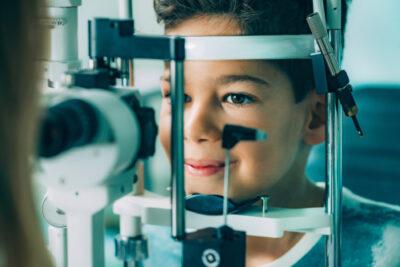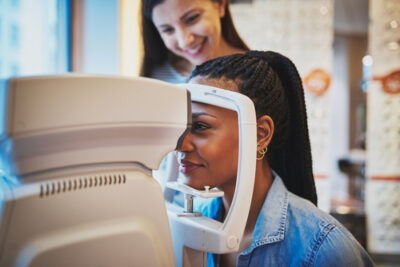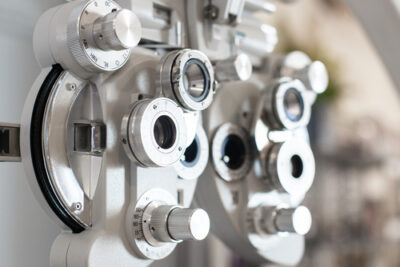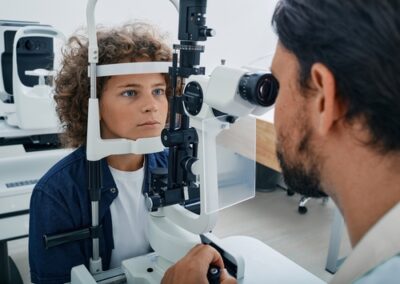Just like you need routine checkups with your primary care physician or dentist, it’s also best to see your eye doctor routinely to ensure your eyes are healthy. Even if you aren’t experiencing any changes to your vision, routine eye exams are still essential for the early detection of many common eye conditions.
How often you should visit your eye doctor depends on a number of factors. These factors can include your age and risk level for eye disease.
Keep reading to learn more about how often you should schedule a vision exam with your ophthalmologist!
General Recommendations

There are general guidelines that most doctors agree on when it comes to how often you need a comprehensive eye exam. Children should have an eye exam yearly as their vision is more subject to change.
Once they reach the age of eighteen, regular eye exams will not be needed as frequently. If you have no other vision issues, you should ideally still see an eye doctor a couple of times in your twenties and thirties.
But once you turn forty, you should have a vision exam at least once every two years. By the time you’re sixty, you should have them at least once a year.
These general recommendations are only the baseline recommendations. At the very minimum, you should have vision exams regularly after you turn forty.
If you have a refractive error or are at higher risk for certain eye conditions, you may need them more frequently. Your eye doctor will tell you, based on your individual situation, how often they recommend you visit the office for an eye exam.
For Patients with Refractive Errors
If you’re nearsighted, farsighted, or have astigmatism, you should see your eye doctor yearly to ensure that your prescription is up-to-date. After you turn eighteen, your vision is less likely to change significantly.
However, it still tends to change a little over the years. Keeping your prescription current ensures that you have the best vision possible and that you’re able to get the glasses and contacts you need with the correct prescription.
It’s also important to have your eyes examined if you have a refractive error because your doctor can see if your vision is worsening quickly, which may indicate that you have a more serious eye condition. This is especially important as you get older, as you’ll be at higher risk for developing certain eye conditions.
For At-Risk Patients
If you’re at high risk for developing an eye condition based on certain factors like your family history, your doctor may recommend you have eye exams more frequently. The most common age-related eye diseases that you may be at risk for are cataracts, glaucoma, age-related macular degeneration, and diabetic retinopathy.

Some of the factors that may raise your risk for these diseases include:
- Diabetes
- Heart disease
- High blood pressure
- Family history of eye disease
- Tobacco use
- A high refractive error
Some of these general risk factors are in your control. If you lead a healthy lifestyle, don’t smoke, and wear sunglasses, you can lower your risk for some of these eye conditions.
However, some factors are entirely out of your control. Knowing your medical history and family history can help your eye doctor monitor your eyes for certain eye conditions you may be more prone to.
Make sure to give your eye doctor all of this necessary information. Knowing this information, they can then determine your risk for eye disease and recommend eye exams accordingly.

The Importance of Eye Exams
When you go in for a regular eye exam, your doctor will test your visual acuity and eye pressure, among other things. They will also likely perform a refraction test, which is how your eye doctor determines your current prescription.
A comprehensive eye exam also includes examining the inside and back of your eye, particularly the light-sensitive retina. In order to view these structures, you will need to be dilated.
Dilation drops enlarge your pupil. By enlarging your pupil, your eye doctor at your retina and ensure it’s healthy.
Your eye doctor may also use imaging equipment to see detailed maps of the inside of your eye.
Early Detection of Eye Conditions

Comprehensive eye exams are especially important when it comes to detecting certain eye conditions that often present visual symptoms in the early stages. Without any visual symptoms, the only way to spot them before they impact your vision is to examine your eyes.
For example, high intraocular pressure is the first warning sign of glaucoma, and subtle scarring on the retina can indicate macular degeneration or diabetic retinopathy. Having these eye conditions diagnosed early is critical in preventing further damage and vision loss.
It’s also important to know that all these common age-related eye diseases, besides cataracts, cannot be completely cured. However, they can often be managed well enough to slow or prevent vision loss.
With many eye conditions, once you experience vision loss, that vision cannot be restored. For this reason, it’s vital to have these conditions diagnosed before you experience vision loss.
If you have eye exams as regularly as your eye doctor recommends, you can save your vision for years to come.
Is it time for you to have a routine eye exam? Schedule an appointment at Sugiki Portis Eye Center in Honolulu, HI, today!





